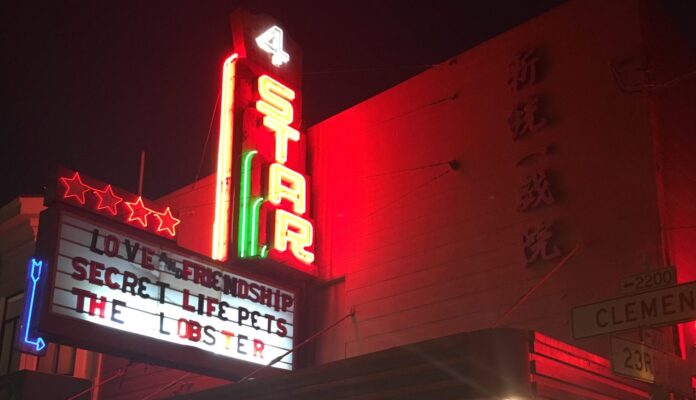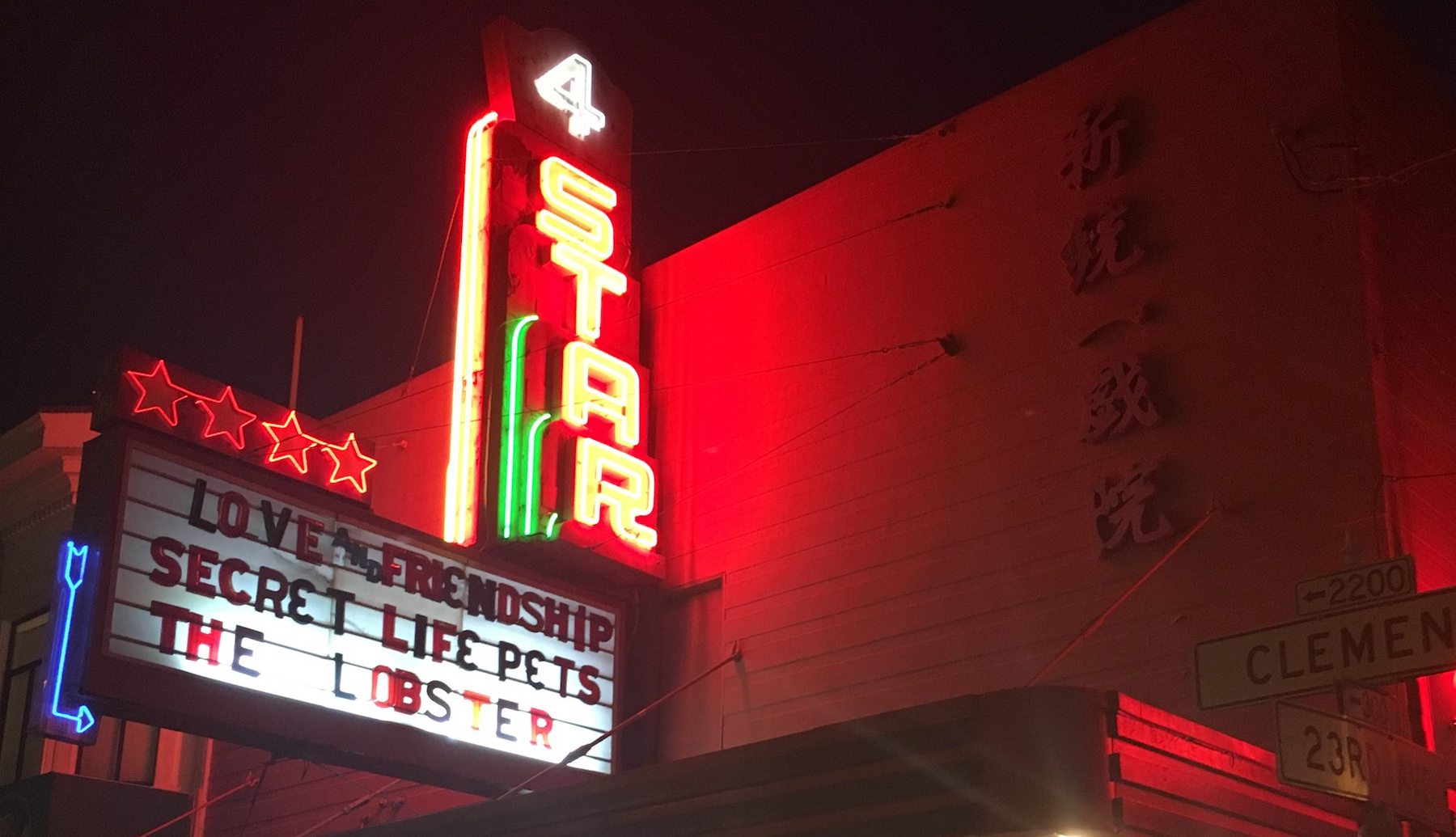It was a happy surprise when the 4Star Theater—which many had assumed was doomed once the building it’s housed in was sold a few years back—re-opened last December, now operated by the same non-profit CinemaSF that’s kept the Balboa and Vogue alive. (Its prior operator, Lee Neighborhood Theatres, still runs the Presidio and Marina movie houses.) Not only is the 110-year-old venue open again, it is new and improved, with its two houses reduced to one, allowing a bigger single screen and a narrow gallery-lobby space to boot. It is also very nice that the 4Star now mixes new releases with repertory-style programming and live (mostly musical) events.
It came as less of a surprise that this renovation-slash-restoration took longer and proved more expensive than anticipated. And it’s downright predictable that as other theaters continue to shutter in an environment seemingly changed for keeps by COVID-altered habits, attendance has not been great. Ergo last week the news hit that the 4Star is in trouble, enough such that CinemaSF has launched a GoFundMe drive to hopefully ride out at least an immediate financial crisis.
There are also benefits hosted by SF Chronicle staffers scheduled at all three of its theaters, on successive Thursdays: on April 6 the Vogue presents Vertigo with a drag-queen-judged noir costume contest; on April 13 the 4Star has a similar competition amongst patron tiaras in conjunction with The Princess Diaries; and on April 27, the Balboa hosts a night of Scottish/SF-themed fun (complete with bagpipes) accompanying Mike Myers’ locally-shot comedy So I Married An Axe Murderer. Of course you could also just show up any time to see new releases like John Wick 4 and Moving On, or to see various upcoming old favorites including The Maltese Falcon, Desperately Seeking Susan, Bound, Blade Runner, Fantasia, 2001, My Own Private Idaho, Easy Rider, and many more. Or just get concession treats to go. For all three CinemaSF venues’ current programs and schedules, go here.
Though the above-named theaters continue to play time-tested cult favorites like Rocky Horror, The Room, Purple Rain, Donnie Darko, and El Topo (all of which are duly playing in coming weeks), let’s face it—the heyday of the “midnight movie” is long past. However, that doesn’t mean filmmakers have stopped making films seemingly custom-tooled for that sensibility, or that programmers have stopped digging up vintage obscurities suited likewise. A handful of new (and a couple old) features getting released this week very much appeal to those with a taste for the surreal and eccentric.
The Son of the Stars
An impressive addition to the celluloid annals of “who knew?” last spring was the belated arrival on US shores of 1984’s Delta Space Mission, a 1984 animated sci-fi adventure from … Romania. The crumbling, famously bleak regime of Nicolae Ceaucescu (who five years later would be one of the least-mourned dictators ever executed after a popular uprising) was not exactly where one would have expected a bizarre futuristic-fantasia ‘toon to emerge from, let alone one that seemed quite so aimed at readers of High Times.
Well, there’s apparently more where that came from. The same team coughed up The Son of the Stars three years later, and it does not disappoint. In the year 6470, child protagonist Dan is being raised aboard spaceship Argos by his Earthling astronaut parents. He’s never seen their home planet, which they are in the process of returning to at last when an accident separates adults from offspring. Supercomputer BOB sets Dan down on the nearest habitable orb, a jungle environ where he’s cared for by telepathic creatures who look like Casper the Friendly Ghost (though one is more of a hairy sock puppet). Upon reaching adulthood, he realizes he must venture back into space to find his parents, meet a mystery babe, and defeat an elusive villain called Van Kleef (presumably after spaghetti western star Lee Van Cleef).
As with Delta, this is a very curious mixture of kidpic and psychedelia—sort of like Johnny Quest meets Carlos Castaneda, complete with “whoa, man” references to things like “space-time mazes no one has been able to escape.” We get cute critters (“Bufi” and “Bu”), Star Wars-type swordplay, a giant floating eyeball, a very cool electronic score, and lots of trippy visuals despite the relatively simple animation. There’s a strangely meditative, inner-journey air to the goings-on, as of someone had decided to adapt the Tarkovskyian sci-fi of Solaris and Stalker for stoned teenage comic-book readers. Newly restored, Mircea Toia and Calin Cazan’s feature (which shows signs at times of possibly having been created as episodic TV) gets released to Blu-ray by Deaf Crocodile Films this Tue/28.
Enys Men
Distinctively odd in a more sinister way is this new feature by Cornish writer-director Mark Jenkin, whose B&W Bait played the Mostly British Festival here just pre-COVID. In 1975, on an island off Cornwall (the county that is England’s southwesternmost “boot”), a middle-aged woman (Mary Woodvine) lives a life so solitary that 20-odd minutes pass onscreen before we hear a word of dialogue.
But is she actually alone? Are the young woman and older man she occasionally interacts with real, memories, or figments of her imagination? For that matter, is the Mobius strip-like repetition of subtly altering events here a matter of personal recollection, dreams, or haunted fragments from this isolated location’s restive collective past? Our protagonist seems very concerned with details of local flora and fauna—as well she might be, since at a certain point lichen begins growing on her own skin.
This mystifying narrative has been classified as “folk horror” in the realm of the original Wicker Man and recent Midsommar, but it’s practically an experimental film by comparison, a kind of poetic audiovisual abstraction. Which is not to say it isn’t compelling—just that you’ll need to let go of conventional expectations (for action, or explication) to fully enjoy its creepily hypnotic effect. Enys Men opens at the Roxie Wed/29.
Country Gold
A contrastingly very ‘merican warp in the fabric of reality can be had in the latest from Mickey Reece, a confoundingly prolific and idiosyncratic Oklahoman who’s just starting to attract a wider audience after cranking out umpteen DIY features and shorts in the last 15 years. He plays the lead here himself: Troyal Brux, a thinly-veiled version of Garth Brooks, who in 1994 is already “outselling Madonna and Michael Jackson.” That success attracts the attention of his hero, the notoriously hard-living George Jones (Ben Hall.) The veteran star invites the newbie for a Nashville tête-à-tête in which the latter’s attempted worshipfulness immediately runs into the sharp edge of the former’s embittered jadedness.
Their first/last meetup—ailing Jones confesses he plans to get cryogenically frozen on the morrow—soon becomes a long night’s disillusioning debauch. But this is no Payday, let alone a countrified A Star Is Born. Reece’s B&W fan fiction throws in brief animation, a parody of Brooks’ infamous “Chris Gaines” persona (when he tried to make like an indie grunge rocker), an absurd espionage flashback, and other perverse fillips. Like most of Reece’s joints, Gold can be seen as little more than an attenuated goof. Still, it’s a diverting, accomplished goof. It plays the Alamo Drafthouse New Mission on Wed/29, then begins streaming on Fandor April 4.
I’m An Electric Lampshade
The real-life Jones and Brooks became stars via hard slogging and popular assent. But can music stardom be bought? That may not be the question this “docufiction” hybrid wants you to walk away with, but it’s what I was left pondering. Subject (and producer) Doug McCorkle is a milquetoast-y upstate NY corporate accountant who upon retiring at the age of 60 decides to realize his dream of becoming a pop idol. To that end, he hires a personal trainer, then travels to the Philippines in order to attend “Sin Andre’s Finishing School for Performers.” There, the pupils are primarily drag queens, and the “lessons” are primarily in things like runway walking, makeup application, and so forth.
Thus at an early point, John Clayton Doyle’s film abandons its pretense of nonfiction for a pretty silly, cutesy, obviously staged fantasy whose 96 minutes are largely like one very long music video. Some have found it “inspirational,” in a “you’re never too old to follow your dreams” way. But I wasn’t buying it, and the slick, flashy packaging only made the hard sell queasier. What exactly IS Doug’s dream? Is it funding his own elaborate vanity project, culminating in a “concert” attended by “screaming fans” who are presumably paid extras? He’s credited as a cowriter on at least some of the variably generic/gimmicky electropop songs performed, and he can sing passably within a very limited range. But we never get any clear sense that he has a vision—of his own star persona or musical style, let alone costumes or choreography—that somebody else wasn’t paid to create for him, sewing together Frankensteinian bits and pieces of other artists’ ideas.
It would be one thing if this were presented as deliberate pastiche, or performance art. But we’re meant to accept it as healing self-expression—as something real, even sincere. The only “real” thing here is Doug, and after a while I wasn’t so sure about him, either. I watched Electric Lampshade partly because Doyle had been so brilliant a performer in Jacob Krupnick’s 2011 Girl Walk: All Day, an equally outré conceit. However, it had three rock solid conceptual through lines: The music of mashup master Girl Talk (aka Gregg Gillis), a physical route through Manhattan, and inspired dancers to make their way through both. It was a magical collective effort.
By contrast this movie, shot at an evidently considerable expense (there are also scenes in Mexico), seems to exist solely to fulfill one not-conspicuously-talented guy’s Make A Wish fantasy of stardom. Well, sure: It’s his money, let him have it. But what’s in it for us? The “inspirational” news that if you’ve got a lot of cash to blow, you too can hire the crew and consultants to pose as a pop icon for a few ephemeral moments? I’ll pass, thanks. Lampshade releases to digital and On Demand formats Tue/28.
Book of Days
Last but very far from least in this motley crew is the sole feature to date by Meredith Monk, a leading figure as composer, choreographer, and theatrical multimedia artist in the American avant-garde of the last six decades. Though sometimes classified with such musical contemporaries as Steve Reich or Philip Glass, her primary (often exclusive) vocal emphasis in composition is distinguishing—from those two famous peers, and really from anyone else you could name save her own imitators.
Though she’s worked in venues from performance art spaces to symphonic halls and opera houses, not-infrequently deploying projected elements, Book is the only time she’s hazarded the cinema. (Unless you count her soundtrack appearances, which encompass films by the Coens, David Byrne, and Terrence Malick.) It was, regrettably, an experiment not to be repeated—when the Castro Theater booked a run in 1990, a doltish “What’s this arty shit” review in the SF Chronicle ensured tumbleweeds blew through the auditorium, and it was not much better received elsewhere. (34 years later, there is exactly one user comment on the Internet Movie Database—and no, it’s not mine.)
But Book of Days, which the Roxie is giving a very rare one-show revival on 35mm this Thu/30, is a singular if esoteric achievement. Like so much of Monk’s music, it utilizes a simplicity that can at first seem childlike to profound, mystical, and touching effect. The story, such as it is, involves daily life in a medieval European Jewish shetl. Yet the B&W images and simultaneously sing-song/dirge-like sounds are also unmoored from time, suggesting past, present, and future sit together on the edge of a cosmic apocalypticism. This is the sort of enterprise you need to slow down your viewing pulse for, in order to receive an experience truly worthy of the term “transcendental cinema.”





